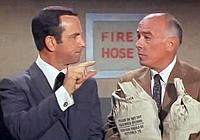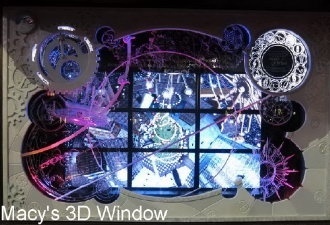
Missed it by THAT much
November 23, 2011 by Dave Haynes
 Display Daily has an insightful piece out today about the iconic Christmas windows at Macy’s on 34th Street in New York, and an attempt at introducing glasses-free 3D into the displays.
Display Daily has an insightful piece out today about the iconic Christmas windows at Macy’s on 34th Street in New York, and an attempt at introducing glasses-free 3D into the displays.
As Maxwell Smart would often say, the people who pulled it together apparently “missed it by THAT much.”
Macy’s put a 132-inch autostereoscopic 3D display in one of the windows this year, working with 3DFusion.
Reports analyst Matt Brennesholtz: The window, as finally produced, uses a 3 x 3 array of 42-inch autostereoscopic panels to produce the image. The panels, unfortunately, had relatively large bezels, with approximately a 2½ inch dark space between adjacent images. This forced the 3D content to all be behind the screen to avoid serious 3D artifacts. It made it look like you were watching a world through a French window, which in fact, is not a bad match for the holiday season.
The content was, of course, produced by Macy’s as 2D content. It was a 90-second loop of a spaceship on a star field. Presumably delivering wishes to children, since the windows all had a Make-a-Wish Foundation theme. The content was converted to autostereoscopic 3D by 3DFusion, using their proprietary plug-ins to Autodesk’s 3D Studio Max. Special plug-ins were developed for this project and Blumenthal said the software people at 3DFusion worked 24/7 for a while to get this software to work right.
Blumenthal said 3DFusion didn’t really need a 3D input file for this project since it would have been stereoscopic and the first thing they would have done was convert it to the 2D plus a depth map they need to produce multiview 3D content. He said the depth map was generated from the 2D file semi-automatically using the 3DFusion software plug-ins.
(Note: I won’t even pretend to act like I understood that passage.)
The end result was pretty good and the crowds at Macy’s the night I was there didn’t seem to mind that the results weren’t perfect. Blumenthal told me the intention was to produce a “sweet spot” about 20? wide and 10? deep that started about 8? from the displays. Since the displays were about 4? behind the window, that meant you needed to stay at least 4? back from the window to be in the sweet spot.
While that was possible on the chilly and damp night before Thanksgiving that I was there, it may not be practical as the crowds get larger closer to Christmas. Even on the night I was there, I couldn’t really find the sweet spot for all 9 displays because of the crowd issues. Blumenthal said that 3DFusion will be tweaking the software and the displays all through the Christmas season to optimize performance and told me I should come back to see the results.
Here’s what I know. There is definitely a cost delta between panels with thick bezels and the ultra thin ones on the market now. This project used the displays that 3DFusion markets, which has the lenticular lens that creates the 3D effect as an overlay.
I’m not all that sure if there even is a truly thin bezel product out there that can do this.
But what’s clear is an interesting effort can be a bit of a bust if compromises have to be made in how it all looks. You need a set of displays to make something big and impactful. But when that requires a big, ugly set of grid lines, was it worth it?
Maybe, maybe not. If it gets the little kids looking in the windows excited, I suppose that’s mission accomplished. One day soon bezel will an archaic concern in this industry.
Phot0 shamelessly appropriated from Display Daily



Leave a comment